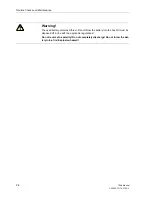
Installation and Commissioning
8-74
7SA6 Manual
C53000-G1176-C156-2
8.3.13.3 Transfer Trip Signal Transmission for Breaker Failure Protection and/or Stub Protection
If the transfer trip command for breaker failure protection or stub protection is to be
transmitted to the remote end, this transmission must also be checked.
To check the transmission the breaker failure protection function is initiated by a test
current (secondary) with the circuit breaker in the open position. Make sure that the
correct circuit breaker reaction takes place at the remote end.
Each transmission path must be checked on lines with more than two ends.
8.3.13.4 Signal Transmission for Intertripping and Direct Transfer Tripping
The 7SA6 provides the possibility to transmit a remote trip signal to the opposite line
end if a signal transmission path is available for this purpose. This remote trip signal
may be derived from both an internally generated trip signal (intertrip) as well as from
any signal coming from an external protection or control device (direct transfer trip).
If an internal signal is used, the initiation of the transmitter must be checked. If the sig-
nal transmission path is the same and has already been checked in one of the previ-
ous subsections, it need not be checked again here. Otherwise the initiating event is
simulated and the response of the circuit breaker at the opposite line end is verified.
In the case of the distance protection, the permissive underreach scheme may be
used to trip the remote line end. The procedure is then the same as was the case for
permissive underreach (Sub-section 8.3.13.1 under “Permissive Underreach Trans-
fer”); however the received signal causes a direct trip.
For the remote transmission, the external command input is employed on the receiv-
ing line end; it is therefore a prerequisite that: in address
122
the setting
DTT Direct
Trip
is set to
Enabled
and that in address
2201
the setting
DTT Direct Trip
is
set to
ON
. If the signal transmission path is the same and has already been checked
as part of the previous subsections, it need not be checked again here. A function
check is sufficient, whereby the externally derived command is executed. For this pur-
pose the external tripping event is simulated and the response of the circuit breaker at
the opposite line end is verified.
8.3.14 Testing User-Defined Functions
7SA6 has a vast capability for allowing functions to be defined by the user, especially
with the CFC logic. Any special function or logic added to the device must be checked.
Naturally, general test procedures cannot be given. Rather, the configuration of these
user defined functions and the necessary associated conditions must be known and
verified. Of particular importance are possible interlocking conditions of the switch-
gear (circuit breakers, isolators, etc.). They must be considered and tested.
Summary of Contents for siprotec 7SA6
Page 2: ...Siemens Aktiengesellschaft Book No C53000 G1176 C156 2 ...
Page 18: ...xviii 7SA6 Manual C53000 G1176 C156 2 ...
Page 32: ...Introduction 1 14 7SA6 Manual C53000 G1176 C156 2 ...
Page 82: ...Hardware and Connections 2 50 7SA6 Manual C53000 G1176 C156 2 ...
Page 119: ...SIPROTEC 4 Devices 4 25 7SA6 Manual C53000 G1176 C156 2 Figure 4 20 CFC Logic example ...
Page 190: ...Configuration 5 62 7SA6 Manual C53000 G1176 C156 2 ...
Page 652: ...Installation and Commissioning 8 78 7SA6 Manual C53000 G1176 C156 2 ...
Page 724: ...Technical Data 10 56 7SA6 Manual C53000 G1176 C156 ...
Page 800: ...Appendix A 76 7SA6 Manual C53000 G1176 C156 2 ...
Page 866: ...Appendix B 66 7SA6 Manual C53000 G1176 C156 2 ...
















































